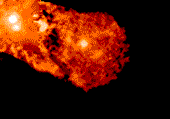
— Calvin J. Hamilton
|
Origins Table of Contents |
|
More Information |
The Earliest Stars

|
| Young star. [more] |
The fiery birth of a new star can be quite dramatic as in the example of XZ Tauri shown above and HH 30's Jet to the right. Following its birth, the star enters a new phase of existance in which it leads a rather tranquil life as an inhabitant of the galaxy.
Eventually, all the hydrogen, helium, and those products that could be used to generate energy in the core of the star, were exhausted, and the nuclear furnace was extinguished. The outer layers of the star could no longer resist the central force of gravity, which was pulling the star's outer matter inward toward its core. What happened next depended on the mass of the star. In some cases it collapsed to white dwarf star, a dim planet-sized object that is extraordinarily dense because it retains most of its initial mass. An extreamly massive star would undergo catastropic core collapse, exploding violently and rapidly as a supernova, creating even heavier elements, and spewing much of the stellar material into space.
In other cases, a star's death was slower; instead of an explosion, elements from the star's interior zones rose to the surface and were then lost to space when the outer layers blew off. The end results were similar: the space between the stars was enriched with heavy elements, many of which condensed to form small solid grains. The processes of the birth and death of stars occurred over and over again, with each successive generation of stars starting off with a greater quantity of heavy elements than the previous generation.
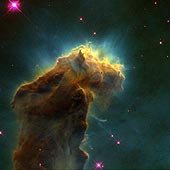 |
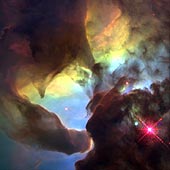 |
 |
| Eagle Nebula [more] | Lagoon Nebula [more] | Orion Nebula [more] |
| These images are examples of regions in our Milky Way galaxy that are enriched areas capable of undergoing star formation. The Eagle, Lagoon and Orion Nebulas all show the presence of heavy element, an abundance of dust and physical structures that appear to be fragmenting into newly formed protostars. | ||
The Birth of Our Sun
Scientists believe that the Sun and our solar system formed at nearly the same time out of the solar nebula - an enriched interstellar gas and dust cloud that existed where our solar system now lives. The theorized order of events for the birth of our Sun is similar to what we see in newly forming stars today. Compression from nearby disturbances causes the interstellar medium to collapse. Small clumps of gas and dust break away from the larger cloud. These denser knots have gravity and begin to gather other gas and dust around them. Temperatures begin to rise due to the further increase in gravity from material in the collapsing gas cloud. The center of this fragmented gas cloud evolves quickly (over the next 100,000 years) to form a protostar and once pressure and temperatures reach a peak, nuclear fusion begins.
The Life and Death of Stars
All stars in our galaxy and in all galaxies use the process of nuclear fusion to create energy, light and heat. The initial mass of the star is an important factor involved with the life of a star and helps to answer many other questions: how long will the star live, at what temperature will it emit radiation, and at what part of the electromagnetic spectrum will the radiation be emitted. Stars also make up much of the visible portion of the universe and help to illuminate gas, dust and even planets that may orbit a star. The following images serve to illustrate stars of different sizes and stages in their life:
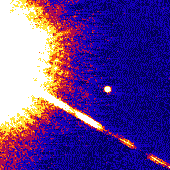 A Small Brown Dwarf Star
A Small Brown Dwarf Star
One of the smallest star's ever observed is that of the brown dwarf orbiting
a cool red star Gliese 229, called Gliese 229B (GL229B). But is it really a star?
GL229B is less massive than the theoritical limit (eight percent the mass of our
Sun) where a star has enough mass to sustain nuclear fusion.
It is estimated to be 20 to 50 times the mass of Jupiter,
but is too hot to be classified as a planet and is too dim to shine like a star.
It is at least 100,000 times dimmer than our own Sun. GL229B's atmosphere resembles
that of a gas planet more than it does a Sun.
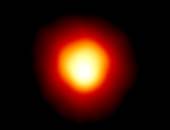 Alpha Orionis - Betelgeuse
Alpha Orionis - Betelgeuse
Alpha Orionis, commonly known as Betelgeuse is a red supergiant star marking the shoulder
of the winter constellation Orion the Hunter. Betelgeuse is so huge that, if it replace the Sun
at the center of our Solar System, its outer atmosphere would extend past the orbit of
Jupiter. The Hubble Space Telescope was able to resolve the atmosphere of this
giant star. One of the unusual features is a mysterious hot spot on the stellar behemoth's
surface. The enormous bright spot, more than ten times the diameter of Earth, is at least
2,000 Kelvin degrees hotter than the surface of the star.
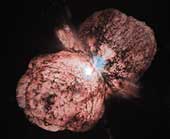 Eta Carinae
Eta Carinae
A huge, billowing pair of gas and dust clouds are captured in this stunning image
of the supermassive star Eta Carinae. It is estimated to be 100 times more massive
than our Sun and may be one of the most massive stars in our Galaxy. It radiates about
five million times more power than our Sun.
Eta Carinae was the site of a giant outburst about 150 years ago, when it became one
of the brightest stars in the southern sky. Though the star released as much
visible light as a supernova explosion, it survived the outburst. Somehow the explosion
produced two polar lobes and a large thin equatorial disk, all moving outward at about
1.5 million miles per hour.
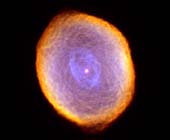 IC 418: The Sirograph Nebula
IC 418: The Sirograph Nebula
Glowing like a multi-facited jewel, the Spirograph nebula IC 418 lies about 2,000 light-years
from Earth in the direction of the constellation Lepus. The planetary nebula represents the
final stage in the evolution of a star similar to our Sun. The star at the center was a
red giant a few thousand years ago, but then ejected its outer layers into space to form
the nebula. The stellar remnant at the center is the hot core of the red giant.
Over the next several thousand years, the nebula will gradually disperse into space, and
then the star will cool and fade away for billions of years as a white dwarf. Our own Sun
is expected to undergo a similar fate, but will not occur until some 5 billion years from
now.